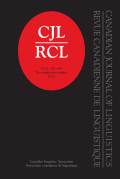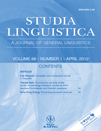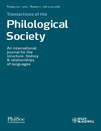
Yuyan Kexue-Linguistic Sciences
Scope & Guideline
Advancing Understanding in Linguistic Sciences
Introduction
Aims and Scopes
- Phonetic and Phonological Studies:
The journal extensively explores tonal variations, sound changes, and phonetic characteristics across various Chinese dialects, contributing to the understanding of phonological systems and their evolution. - Syntax and Morphology:
Research published in the journal delves into syntactic structures and morphological patterns, examining both standard Mandarin and regional dialects, which enhances the theoretical frameworks of syntax and morphology. - Pragmatics and Semantics:
The journal addresses the pragmatic aspects of language, including implicature and meaning construction, providing insights into how language conveys meaning in context. - Dialectology and Language Contact:
A significant focus is placed on dialectal variations and the impact of language contact, allowing for an examination of linguistic diversity and change within the context of sociolinguistic dynamics. - Historical Linguistics:
The journal contributes to the historical understanding of Chinese languages by investigating diachronic changes and the development of linguistic features over time. - Neurolinguistics and Language Processing:
Research on language processing mechanisms, particularly in the context of first and second language acquisition, is a key area, linking linguistic theory with cognitive science.
Trending and Emerging
- Cognitive Linguistics and Language Processing:
There is a marked increase in studies exploring cognitive aspects of language, particularly in relation to how individuals process language both in first and second language contexts, indicating a trend towards understanding language through cognitive frameworks. - Interdisciplinary Approaches:
Emerging themes show a blending of linguistic research with fields such as neurology, psychology, and computational linguistics, reflecting a broader trend towards interdisciplinary collaboration that enriches linguistic inquiry. - Typological and Comparative Studies:
Research comparing different languages and dialects, especially within the Sino-Tibetan language family, is gaining traction, suggesting a shift towards understanding linguistic features in a global context. - Digital Humanities and Computational Linguistics:
The integration of computational methods in linguistic research is becoming increasingly prominent, as scholars utilize digital tools for data analysis, corpus studies, and modeling linguistic phenomena. - Sociolinguistic Dynamics in Language Change:
There is a growing interest in examining how social factors influence language change and variation, particularly in the context of language contact and urbanization, highlighting the relevance of sociolinguistics in contemporary research.
Declining or Waning
- Traditional Historical Linguistics:
Research focusing solely on historical linguistics without integrating modern methodologies or interdisciplinary approaches seems to be less prominent, as scholars increasingly seek to connect historical insights with contemporary linguistic theories. - Descriptive Dialect Studies:
While dialect studies remain important, there is a noticeable decrease in purely descriptive studies that do not engage with broader theoretical frameworks or comparative analyses, which may limit their relevance in current linguistic discourse. - Sociolinguistic Variability:
Themes centered on sociolinguistic variability, particularly in the context of social factors influencing language use, appear less frequently, possibly due to a shift towards more quantitative or experimental approaches. - Simple Syntax Analysis:
Basic analyses of syntax without the application of advanced theoretical models or computational methods are becoming less common, as the field moves towards more complex and nuanced understandings of syntactic structures.
Similar Journals

Taiwan Journal of Linguistics
Exploring the Rich Tapestry of Language and CultureTaiwan Journal of Linguistics, published by CRANE PUBL CO, is a prominent Open Access journal dedicated to the field of linguistics since its inception in 2003. With its ISSN 1729-4649 and E-ISSN 1994-2559, this journal serves as a vital platform for the dissemination of significant research and scholarly discussions from Taiwan and beyond. The journal particularly focuses on advancing knowledge in linguistic theory, language acquisition, phonetics, and sociolinguistics, catering to a diverse academic audience including researchers, professionals, and students. Although it currently holds a Q4 ranking in the Linguistics and Language category, the journal's commitment to quality and accessibility positions it as an emerging resource for those engaged in language studies. Currently ranked #584 in Arts and Humanities and #668 in Social Sciences, it provides critical insights and fosters scholarly exchanges that enhance understanding within the field. The journal's open access model ensures the broadest reach for its published articles, facilitating the global sharing of linguistic research. For more information, visit the journal’s website to explore its latest publications and submission guidelines.

CANADIAN JOURNAL OF LINGUISTICS-REVUE CANADIENNE DE LINGUISTIQUE
Unveiling the complexities of linguistics, one article at a time.The Canadian Journal of Linguistics - Revue canadienne de linguistique is a prestigious peer-reviewed publication dedicated to advancing the field of linguistics. Published by Cambridge University Press, this journal has firmly established itself as a vital resource for researchers, professionals, and students alike, offering insights into a diverse range of linguistic studies and theories. With an impressive impact factor reflecting its academic rigor, the journal is ranked Q2 in the categorization of linguistics and language as of 2023, and holds commendable positions in both Scopus ranks for Arts and Humanities as well as Social Sciences. The journal's converged years span from 1996 to 2024, showcasing a rich history of contributions to the discipline. Although it currently does not offer open access, it remains highly influential. Located in Canada, the journal plays a crucial role in fostering scholarly communication within the linguistic community, making it an essential outlet for disseminating groundbreaking research and engaging discussions.

Journal of Portuguese Linguistics
Advancing Knowledge in Portuguese LinguisticsThe Journal of Portuguese Linguistics is an esteemed peer-reviewed academic journal published by UBIQUITY PRESS LTD, dedicated to the exploration of the rich complexities of the Portuguese language and its various linguistic dimensions. With an ISSN of 1645-4537 and an E-ISSN of 2397-5563, this open-access journal has been disseminating valuable research since 2002, ensuring that knowledge is accessible to all scholars, professionals, and students interested in Linguistics. Based in Portugal, it features a distinct focus on the linguistics pertinent to the Portuguese language, facilitating discussions that span theoretical and applied interests. The journal holds a respectable Q3 quartile rank in the field of Linguistics and Language, reflecting its growing significance and contribution to academia, as evidenced by Scopus rankings that place it in the 71st and 68th percentiles in Arts and Humanities as well as Social Sciences. Researchers and practitioners alike will find Journal of Portuguese Linguistics to be an indispensable resource for fostering discourse and innovation in the study of language.

STUDIA LINGUISTICA
Pioneering Research in the World of LanguageSTUDIA LINGUISTICA is a prestigious journal published by Wiley, focusing on the dynamic and multifaceted fields of Linguistics and Language. With an ISSN of 0039-3193 and an E-ISSN of 1467-9582, the journal has been a vital resource for academics since its inception in 1947, diligently converging insights from history and philosophy of science alongside contemporary linguistic research. Demonstrating excellent scholarly impact, STUDIA LINGUISTICA proudly holds a Q1 ranking in Linguistics and Language as well as a Q2 in History and Philosophy of Science as of 2023, indicating its significance within these academic domains. Furthermore, it ranks in the top percentiles among similar journals, with a commendable 73rd percentile in Language and Linguistics and 70th in related social sciences. Although it does not offer Open Access, its contribution to the discourse of language studies is underpinned by rigorous peer-review processes and commitment to advancing theoretical and empirical research. For researchers, professionals, and students alike, STUDIA LINGUISTICA remains an essential platform for disseminating impactful linguistic scholarship worldwide.

TRANSACTIONS OF THE PHILOLOGICAL SOCIETY
Exploring the Depths of Linguistic KnowledgeTRANSACTIONS OF THE PHILOLOGICAL SOCIETY, published by Wiley, is a prestigious journal focusing on the fields of linguistics and language studies. With a rich history that spans over 180 years, having been established in 1842, this journal continues to contribute significantly to the academic discourse on language and linguistics. It holds an impressive impact factor and ranks in the Q2 category for both Linguistics and Language in the 2023 category quartiles, underscoring its relevance and scholarly influence, as evidenced by its rankings in the Scopus database. Researchers, professionals, and students will find this journal invaluable for accessing high-quality research articles that illuminate various aspects of language and linguistics. While the journal does not currently offer open access, it remains a vital resource for anyone dedicated to advancing knowledge in these fields. Its address in the United Kingdom underscores its international reach and commitment to academic excellence.

Glossa-A Journal of General Linguistics
Fostering Dialogue Across Linguistic DisciplinesGlossa: A Journal of General Linguistics, published by the Open Library of Humanities, stands as a leading voice in the realm of linguistic research since its inception in 2016. With its Q1 category ranking in Linguistics and Language and impressive Scopus ranks encompassing the top 83rd and 81st percentiles in its respective fields, Glossa fosters a vibrant academic community committed to the rigorous exploration of language and linguistic theory. Operating under an open access model, the journal not only enhances the visibility of groundbreaking research but also ensures that valuable insights are accessible to a global audience. The journal's commitment to interdisciplinary dialogue makes it an indispensable resource for scholars, professionals, and students eager to engage with contemporary developments in linguistics. As it converges into 2024, Glossa continues to champion innovative scholarship and critical discourse that challenges conventional boundaries within the field.

Revista de Investigacion Linguistica
Advancing linguistic knowledge for a global audience.Revista de Investigacion Linguistica is a distinguished open-access journal dedicated to the exploration and advancement of linguistic research, published by the University of Murcia since its inception in 1997. With the ISSN 1139-1146 and E-ISSN 1989-4554, this journal serves as a vital resource for linguistics scholars and enthusiasts around the globe. Located in the vibrant city of Murcia, Spain, the journal aims to foster academic discourse by disseminating high-quality research that covers a broad spectrum of linguistic topics, including syntax, semantics, phonetics, and sociolinguistics. Its commitment to open access ensures that knowledge is freely available, promoting a wider reach and impact in the academic community. By contributing to the advancement of linguistic studies, the Revista de Investigacion Linguistica plays a crucial role in shaping contemporary linguistic theories and practices, making it an essential publication for researchers, professionals, and students alike.

Voprosy Yazykoznaniya
Unveiling the Complexities of CommunicationVoprosy Yazykoznaniya, published by the esteemed Russian Academy of Sciences and the State Academy of Humanities (GAUGN), stands as a leading journal in the field of linguistics and language studies. With an impressive Q2 rank in Linguistics and Language for 2023 and a strong position within Scopus rankings, this journal fosters scholarly dialogue and pushes the boundaries of linguistic research by providing a platform for innovative studies, reviews, and analyses. Although not open access, its publication ensures high academic standards and visibility within the global academic community. Researchers, professionals, and students alike can benefit from the rich insights and diverse perspectives presented in this journal, serving as a vital resource for anyone interested in the intricacies of language and its role in society. Operating since 2009 and continuing to 2024, Voprosy Yazykoznaniya is an essential reference point for contemporary linguistic scholarship in the Russian Federation and beyond.

Jezikoslovlje
Elevating Understanding Through Rigorous Linguistic InquiryJezikoslovlje, published by the Josip Juraj Strossmayer University, Faculty of Philosophy in Croatia, is an essential publication in the field of Linguistics and Language Studies. Launched in 2008 and extending its contributions to the academic community through 2024, this journal addresses a spectrum of linguistic research, facilitating scholarly dialogue around both theoretical and applied aspects of language. With a current Scopus ranking placing it in the 54th percentile in the Arts and Humanities and the 50th percentile in Social Sciences, Jezikoslovlje serves as a vital resource for researchers and students looking to engage with contemporary linguistic issues. Although it operates under a traditional access model, its indexed presence and rigorous peer-review process ensure that published works maintain a high scholarly standard, inviting contributions that advance understanding in this dynamic discipline. The journal's commitment to fostering knowledge in linguistics makes it a significant platform for academics in Croatia and beyond.

Languages
Empowering researchers with accessible insights into language studies.Languages, published by MDPI, is a prestigious open-access journal dedicated to the field of Linguistics and Language studies. Since its inception in 2016, this journal has rapidly established itself as a leading platform for high-quality research, achieving an impressive Q1 ranking in 2023 and standing out in both the Arts and Humanities as well as the Social Sciences categories with significant percentile rankings (76th and 74th respectively). Based in Switzerland, Languages fosters an international community of scholars who are committed to exploring the multifaceted dimensions of language, from theoretical frameworks to practical applications. With a robust e-ISSN of 2226-471X, the journal prioritizes accessibility, allowing researchers, professionals, and students to freely engage with cutting-edge research and insights. By bridging the gap between theory and practice, Languages plays a crucial role in advancing our understanding of linguistic phenomena, making it an invaluable resource for anyone invested in the study of language.